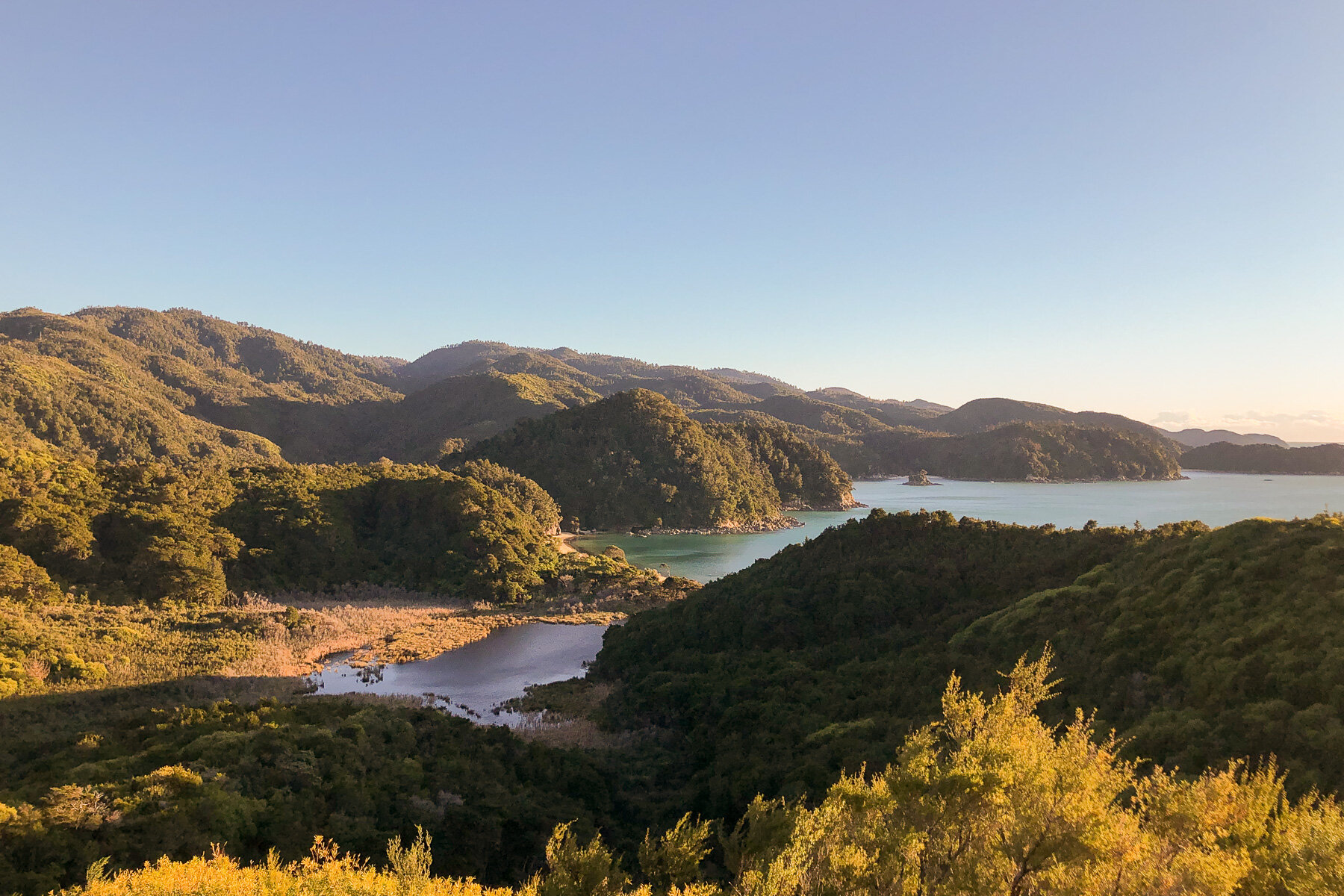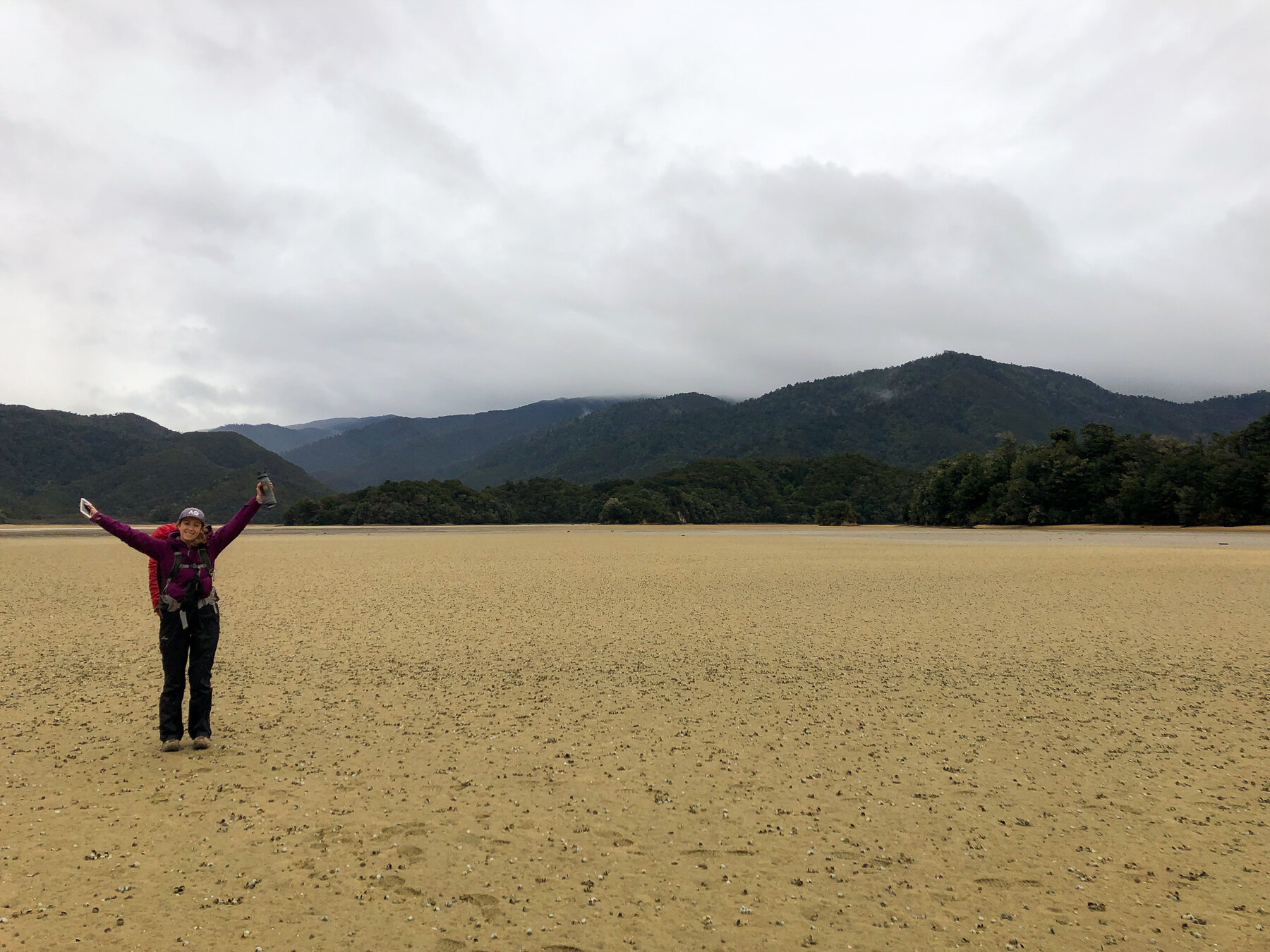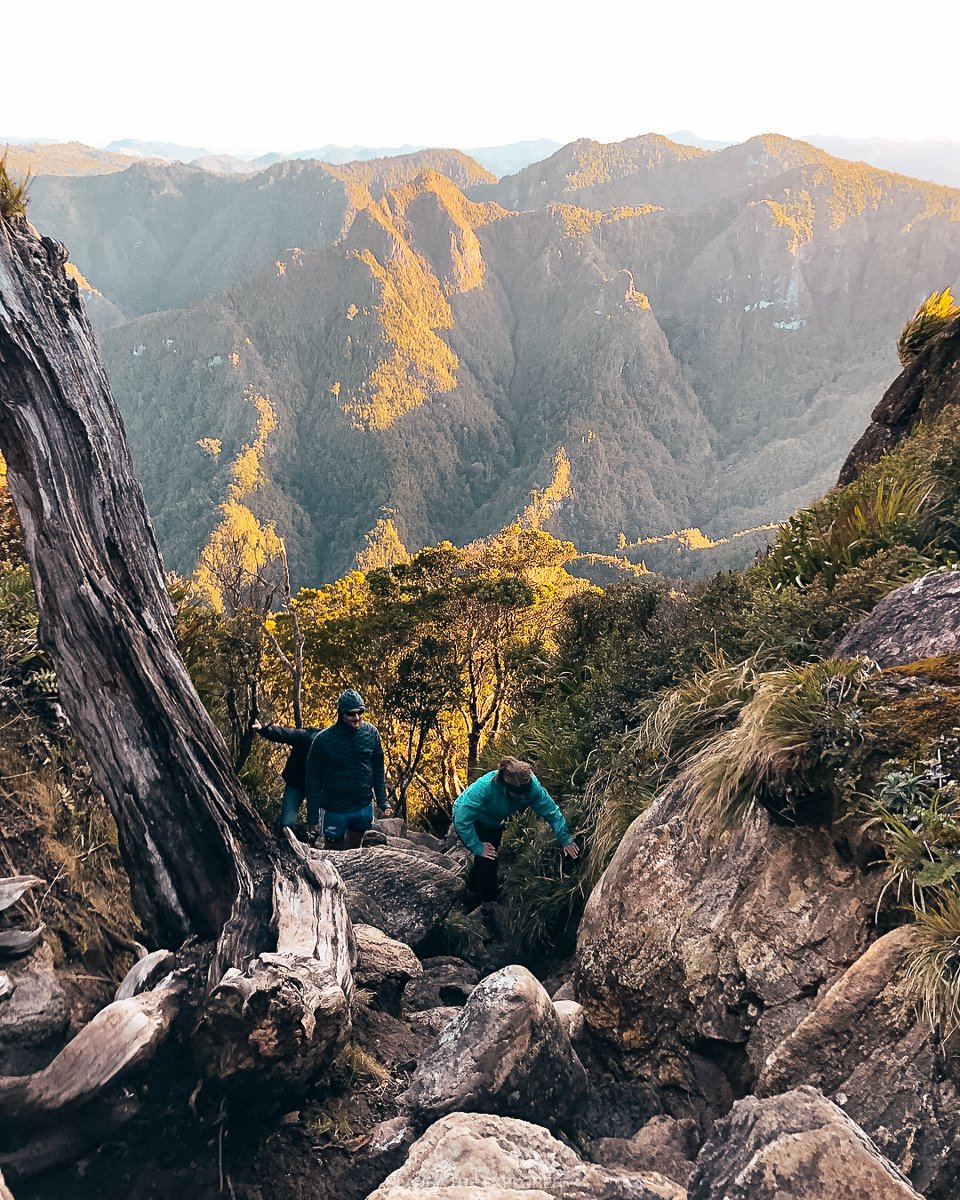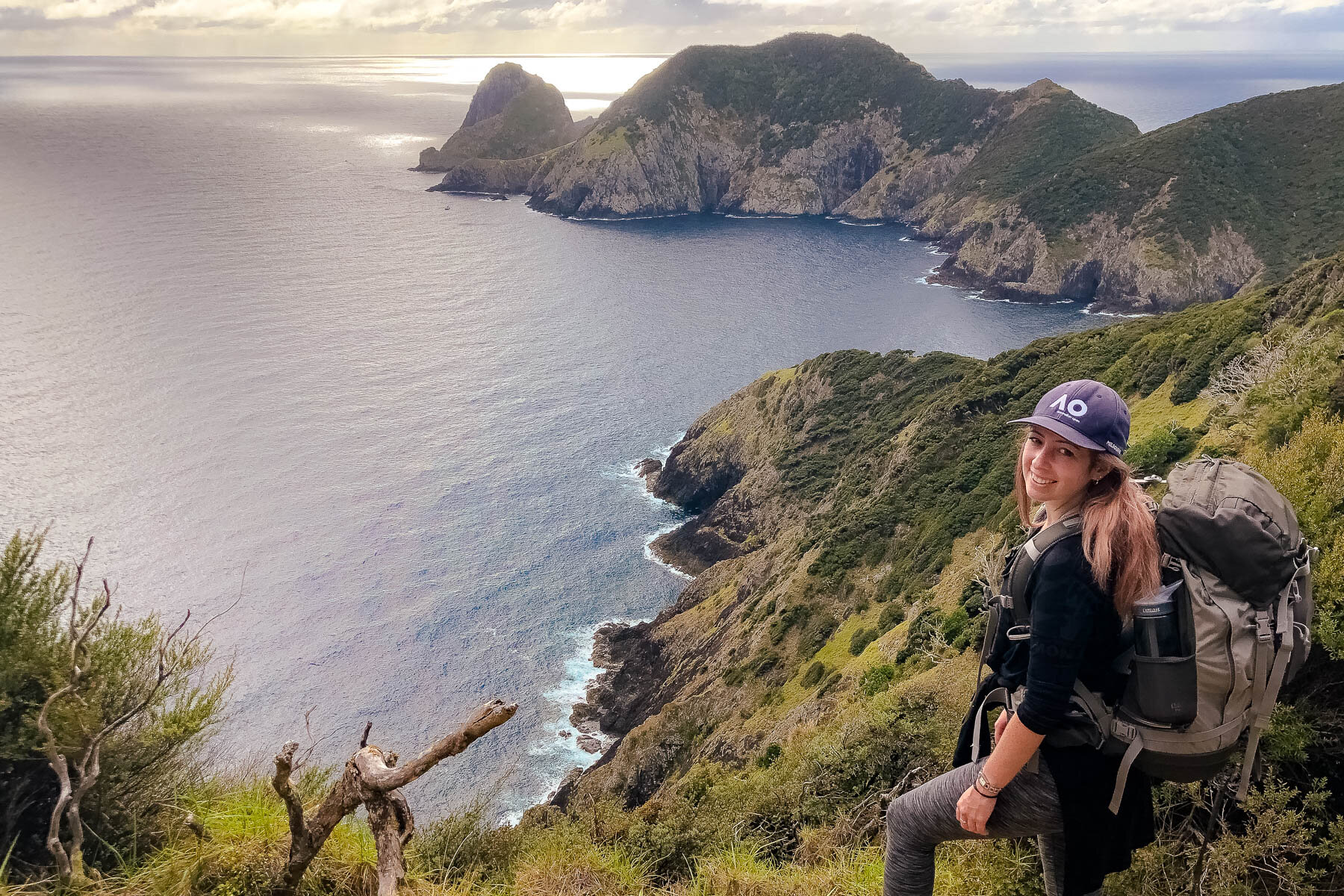Great Walks Packing List for Hiking the Abel Tasman Coast Track
One of the great things about the Abel Tasman Coast Track is that it can be hiked (or kayaked!) at any time of year. Whilst many of the high alpine Great Walks are closed for the winter season due to avalanche risks, this track really shines on a clear winter’s day.
Winter requires an adjustment to the typical the Abel Tasman Track packing list. Thanks to the high availability in the huts, even last minute, there’s no need to bring a tent or a mattress, though you’ll probably want to throw in a full set of wet weather gear.
Weather in New Zealand can be unpredictable at the best of times, and though the track is pretty sheltered throughout, we experienced all conditions. Fog, downpours, drizzle, bright sunshine and a blistering cold southerly blast that puts snow on the surrounding mountains. Yep, hiking in New Zealand can have it all.
Average daytime temperatures in winter range from 12-16 degrees Celsius, so it’s a pretty mild winter. Be aware that temperatures do drop off at night, but all of the huts have fires so they should be comfortably warm.
So what do you need to pack for a multi-day hike on the Abel Tasman Coast Track? Get organised with this Great Walks packing list.
COMPLETE GREAT WALKS PACKING LIST FOR THE ABEL TASMAN COAST TRACK
HIKING EQUIPMENT
» WHAT PACK TO TAKE ON THE ABEL TASMAN COAST TRACK
A 40-60L pack is perfect for a three or four night hike in the Abel Tasman. Whilst we each carried our own all-seasons weight sleeping bags, we distributed the cooker and gas, pot and washing up kit between two of us. Sharing is caring right!
My pack is an older version of this 46L Ospery pack. I prefer a small pack like this to keep the weight down as much as possible, I would struggle carrying anything bigger. Some of the key features are the stretchy mesh pocket on the back that’s perfect for throwing a pair of flip flops or a spare layer in on the go, and the built in waterproof cover with it’s dedicated storage compartment. Both features came in handy on the track!
» WHAT EQUIPMENT TO TAKE ON THE ABEL TASMAN COAST TRACK
GAS
As there is no cooking gas available in the huts, it’s necessary to take your own supply. As we were flying in to Nelson to start the track, we needed to stop somewhere locally to pick up gas (it can’t be taken carry on or checked!). On our drive through Motueka, we stopped in at the local outdoors store to pick up a canister, and used it with a small cooker like this one here.
SLEEPING BAG
Whilst we slept cosily in all three huts, I wouldn’t have wanted a fully summer wieght sleeping bag. This three-seasons Kathmandu one was the perfect option for the Abel Tasman over winter.
PACKING SACKS
Dry sacks and dry bags are other essential items for hiking during a New Zealand winter. On rainy days, I kept my sleeping bag and clothes in this ultra light dry sack, and my battery pack and Kindle in a small dry bag similar to this. On the sunny days, the dry sack also came in handy to store my wet clothes that didn’t quite dry overnight.
Prepare for all weather on a New Zealand hike.
FOOTWEAR FOR THE ABEL TASMAN COAST TRACK
» BOOTS & HIKING SOCKS
Whilst you might get away with runners during summer, I’d recommend proper hiking shoes or boots for winter. The track wasn’t particularly muddy, but a lot of the trail surface is clay so having good grip is important. My well broken in boots are no longer available but these are pretty similar.
Perhaps controversially, a like to run double socks when hiking as it seems to help with blisters and staying dry. The first layer are these thin merino ankle socks, followed by a thick pair of merino hiking socks. Their length is also key to stop any pesky mosquitos nipping at your ankles at lunch time! Typically, this double set will do two hiking days, so this trip required two sets.
Also bring a pair of regular cotton socks for inside the hut.
» HUT SHOES
A pair of flip flops, sandals or other light shoes always come in handy at the hut. It’s a standard DOC hut rule that hiking boots are kept outside (there are hooks provided to keep them out of reach of the cheeky local wekas) so spare footwear is key for inside the huts, and trips outside to the loo!
» WATER SHOES
Another necessary piece of footwear for the Abel Tasman is a pair of reef booties, or well strapped sandals. I realised last minute while packing that mine were away in storage, and really regretted not having them - specifically for the Awaroa Inlet crossing. We naively thought that we’d be okay crossing the Awaroa estuary in our flip flops, or maybe even our hiking boots if the water level was low enough…
No chance.
The muddy estuary surface will hold on to your flip flops like glue, and despite crossing at bang on low tide, the water was up over our knees in places. So we battled across barefooted, wincing as every pipi shell dug into our numb feet. If it hadn’t have been our first day, we would have sacrificed our boots, but the thought of being stuck with wet boots for three more days was even less appealing!
OUTERWEAR FOR THE ABEL TASMAN COAST TRACK
» RAIN JACKET
A rain jacket is absolutely essential on the Abel Tasman Coast Track. Whilst Nelson might be known as the sunniest place in New Zealand, there’s still an average of 13-15 rain days per month over winter. Even if no rain is predicted, this track can be exposed to cool winds off the ocean, so having that wind breaker is important also.
A rain jacket should be of high quality to ensure it keeps you warm and dry and there are so many options options available, making it important to check the waterproof material. Two of the most popular option are Gore-tex and Pertex (3 layer). Gore-tex is regarded as more durable, whilst Pertex is regarded as lighter weight and less stiff. The current season’s version of my trusted rain jacket can be found here.
» WATERPROOF PANTS
Waterproof pants are also necessary for the Abel Tasman Coast Track over winter. Similar to the jacket above, there are various materials available. Ideally find a balance between performance and weight. If the rain didn’t eventuate and these stayed stashed in your pack, you’ll want to carry as little extra weight as possible! Not owning a pair of waterproof pants before this hike, I picked up this pair, and can confirm they worked a treat in the Tasman rains.
» HEADWEAR & GLOVES
There are also a few accessories needed for this hike. On a sunny hiking day, I run a baseball cap to protect my face from the harsh New Zealand sun, and when that blistering cold southerly came through, this merino headband kept my ears and head toasty warm. Alternatively, a beanie would be a great option, a headband tends to suits a long ponytail a bit better! Also pack a pair of gloves, which might actually came in most handy to block the cold wind.
» A PONCHO
I also always pack one of these ponchos as a backup option. After proving it’s worth in the tropical downpours of the Inca Trail, I’ll always throw one in just in case. However, I’m also aware that these are not environmentally friendly. If you do use one, make sure to drop it off for soft-plastic recycling which are accepted at many supermarkets around New Zealand. You can check locations here.
Pictures can be deceiving - I’m a couple of mins ago from going knee deep in the waters of the Awaroa inlet.
MID & BASE LAYERS NEEDED FOR THE ABEL TASMAN COAST TRACK
» BASE LAYERS
Base layers are absolutely key to keeping warm and dry on a winter hike. These need to be sweat-wicking to keep you dry and warm, such as merino or a synthetic alternative - no cotton here! Try packing one long sleeve baselayer per two days of hiking, plus a short sleeve option in case it gets quite warm.
» MID LAYERS
Mid layers are there for insulation. This could be thin or thick fleece, or a thicker merino layer. As the temperatures weren’t too low for this hike, I opted for regular fleece layers, like this one.
» LEGGINGS
For the bottom half, leggings/yoga pants are my go to over specialised hiking pants. You’re likely to have a pair or two in the closet so it makes most sense, however consider investing in hiking pants if going over rough or rocky terrain to avoid snagging leggings. Luckily, the Abel Tasman is a well formed track so hiking pants aren’t necessary. For me, Lululemon leggings such as these are my go to.
» SHORTS
I also took a pair of running shorts to wear across the Awaroa inlet, however didn’t end up switching into them. It didn’t take long to regret this when I was submerged to mid-thigh - well over my rolled up pants! Lesson learned, wear the shorts!
» HUT CLOTHES
In addition to hiking gear, it’s always great to have a dry set of clothes to throw on once you arrive at the hut. My staple out fit is a pair of these ultra comfortable merino pants, a flannel shirt, and a warm jacket.
TECH FOR A GREAT WALK
Ahh technology. We escape to nature, but there’s no denying that technology will also come along for the ride. What to bring will differ for everyone, but will generally fall into these categories.
» COMMUNICATION
A cellphone or a personal locator beacon (PLB). The track is well defined and it would be hard to get lost, however do note that reception is very sporadic throughout the Abel Tasman National Park. My friend on Vodafone seemed to get better coverage than me on Spark. Note that there is also some wifi available at the Anchorage hut.
» PHOTOGRAPHY
I opted not to take my DSLR on this hike. Firstly, we were expecting rain and wasn’t keen on carrying the additional weight for limited opportunities of use. Secondly, the lens I wanted to carry needs repaired and I hadn’t sorted this in time. I made do with my iPhone which gave a balance between photo quality and practicality.
That said, this hike is extremely photogenic however so it would definitely be worth taking a good camera. And if you’re thinking of kayaking any of the park, a GoPro would be ideal.
» READING
I prefer to take my Kindle over a paperback. On top of having multiple reading options, it also has a built-in, glare-free light which is great for evenings in the candle-lit huts, and it’s waterproof so there’s no worry about damage.
» WEARABLES
I purchased a Garmin smartwatch just before going on this hike, and while no way a necessity, I loved having a record of our time and distance travelled, along with a GPS tracked route for reference. This smaller sized watch fits a petite wrist perfectly.
And don’t forget your power bank and chargers!
Torrent Bay: a perfect spot to stop for lunch.
OTHER ACCESSORIES NEEDED ON THE ABEL TASMAN COAST TRACK
» SUNGLASSES
An essential item for the strong New Zealand sun.
» WATER BOTTLE
Another essential item. Make sure your water bottle holds enough for the day’s hike - at least 1L per person. There is water available at all of the huts and campsites along the track, but note that not all of them are suitable for drinking. For example, the Awaroa hut supply required boiling for three minutes before consumption. A Life Straw or water purifiers such as AquaTabs should also be considered.
» TOILET PAPER & SANITIZER
If you’re not a fan of a long-drop, you’ll be happy to know that all of the huts and campsites we visited had flushing toilets, complete with a good supply of TP and hand washing facilities. Hiking luxury! A backup supply would be sensible but you likely won’t need to use it.
» FIRST AID KIT
Always carry a small first aid kit for blisters and scraps and personal medication. Sunscreen is important, even in winter, and bug repellent is essential too. We thought the sandflies might have disappeared over the cooler winter months, but I can assure you they did not. After crossing the small stream at Onetahuti Beach, we’d barely sat down for 30 seconds at the campsite shelter to re-boot before those pesky little flies had gone full attack mode. I prefer a DEET repellant as they just work so effectively.
» HEADLAMP, CANDLES & WATERPROOF MATCHES
The Anchorage Hut had sensor lighting in the main dining area, as did the Bark Bay Hut (though less effective) however a headtorch is essential for preparing food, hands-free trips to the bathroom and when sorting your backpack (quietly) in the sleeping areas. We also used candles at the Awaroa Hut, where holders were provided throughout the cooking and dining area.
» PILLOWCASE
I always take a pillow case for a little camping luxury. I stuff it with a jacket or fleece for a make-shift pillow.
HOW TO COOK AND WHAT TO EAT ON THE ABEL TASMAN COAST TRACK
There are no cooking utensils or pots/pans etc in any of the huts on the track, so it’ necessary to bring all of your own gear. In addition to the cooker and gas, you’ll need a pot, perhaps a small kettle for boiling water and a small kitchen knife, and then a bowl, a cup and spork.
For cleaning up, make sure to carry a dish towel, a travel-sized bottle of washing liquid and a scrubber. Simple but effective.
Now for the food…
To put it simply, I took way too much food. Maybe due to the rain, we didn’t stop as much as I expected, so the snacking opportunities were a bit limited!
My suggestions for food are:
» BREAKFAST
Cereal and an instant coffee sachet. I just can’t face a bowl of porridge no matter the time of year.
» LUNCH
Foil sachet of tuna on crackers/flatbread or a squished breadroll with cheddar cheese and salami.
» DINNER
A cup of instant soup, followed by instant rice or pasta meals, tofu-based ready meals, usually with some re-hydrated veges added in. I’m not a big fan of the deyhdrated meals, but vege mix is great to add in to rice or pasta.
» SNACKS
You can’t beat a bag of scroggin and I’ll usually get through a few bags of bliss balls.
Like all DOC sites in New Zealand, your rubbish goes out with you, so don’t forget to take along a compostable rubbish sack to keep your rubbish stowed away in your pack.
The finish line! Or the starting line, depending which way you chose to go.
AN ABEL TASMAN COAST TRACK PACKING SUMMARY
All together my pack weighed in at around 10kg, which was a comfortable enough weight to carry for the four days.
However if you’d like to walk with minimal weight, there is an option for pack transfers!
It’s possible to arrange an Abel Tasman pack transfer with the water taxi providers, typically in conjunction with kayak pick up and drop offs. Transfers are currently available through Abel Tasman Kayaks for $20/pack. Note that it will only be possible to transfer packs between Mārahau and Totaranui.
Want to save this guide for later? Pin it!
This blog post was about:












